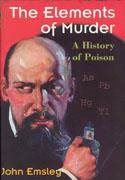Alan Dronsfield reviews this grisly chemistry book
The elements of murder: a history of poison
John Emsley
Oxford: OUP 2005 | Pp421 | £18.99 | ISBN 0 19 280599 1

While I was reviewing this book a recall notice appeared in The Times: 'Reebok is aware of a death from lead poisoning of a child in the USA who reportedly swallowed a piece from these bracelets (free gifts with its footwear)'. Lead is one of the elements featured in John Emsley's book, alongside mercury, arsenic, antimony and thallium. A concluding chapter of 20 pages deals with 12 other elements (barium, copper, potassium etc) that have been associated with fatalities, but seldom employed for murder.
The consideration of each of the main elements can be divided into two sections. First we have 'innocent poisonings' like the poor child mentioned above, and secondly we have 'malevolent poisonings' - murder to inherit, murder to dispose of inconvenient people and (with just a single example) murder in the furtherance of experimentation: the teenage poisoner Graham Young did away with at least three of his family and workmates with antimony and thallium compounds, sometimes one feels, out of a perverse curiosity.
Perhaps more sad are the instances in the first category - a pharmacist who weighed out thallium ethanoate (used in the treatment of ringworm) using faulty scales and 14 out of 16 children given overdoses died. Copper arsenite was a constituent of many 19th century colorants. The compound was used, innocently, to tint a blancmange green and as a consequence three diners met unexpected and painful ends. As a wallpaper pigment, a combination of dampness, gelatine size and flour-derived paste, converts copper arsenite into trimethylarsine which was responsible for many deaths, including two children in the Forest of Dean as late as 1932. Whether (CH3)3 As poisoned Napoleon in 1821 is still disputed and Emsley discusses the evidence for and against.
When it comes to murder, the author concentrates on famous cases in some detail, including the forensic evidence that contributed to the ultimate convictions. Florence Maybrick occupies 23 pages. She appears to have been running a bedroom chemical industry, extracting arsenic from flypapers and from 'black arsenic' (As2O3 mixed with charcoal to minimise risk of accidental consumption). Convicted of poisoning her husband, she escaped the death penalty.
This is a book for the general reader who combines an interest in chemistry with things macabre. Formulae are given for the agents of death in the text, and a glossary provides background information on the elements and the forensic tests used to identify them.






No comments yet